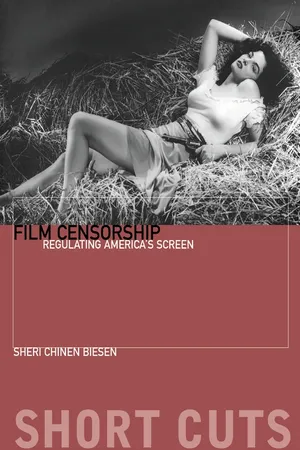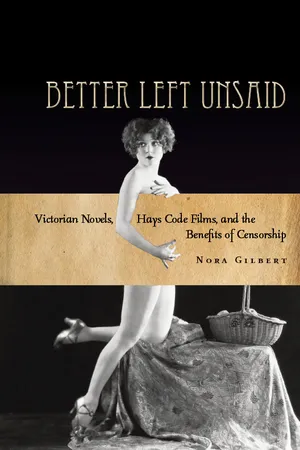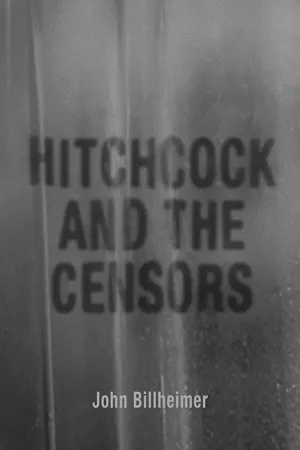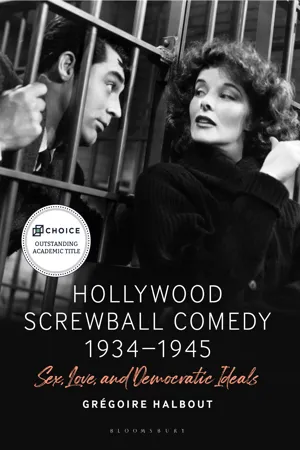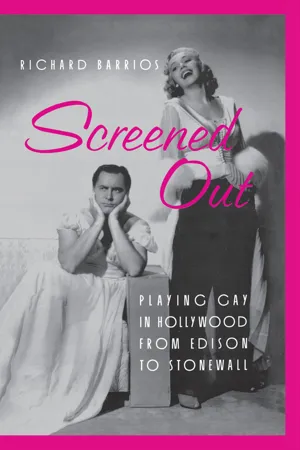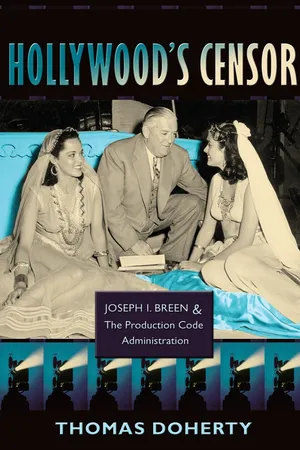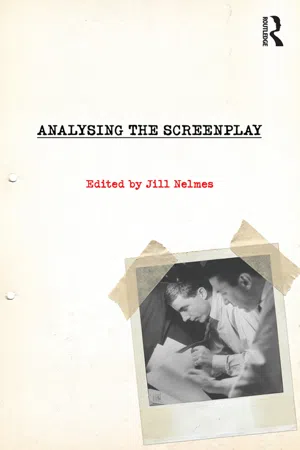History
Motion Picture Production Code
The Motion Picture Production Code, also known as the Hays Code, was a set of industry guidelines for the self-censorship of content in American films. It was implemented in 1930 and enforced until the late 1960s, aiming to maintain moral standards in cinema. The code regulated various aspects of filmmaking, including themes, language, and depictions of violence and sexuality.
Written by Perlego with AI-assistance
Related key terms
Related key terms
1 of 4
Related key terms
1 of 3
10 Key excerpts on "Motion Picture Production Code"
- eBook - ePub
Bible and Cinema
An Introduction
- Adele Reinhartz(Author)
- 2022(Publication Date)
- Routledge(Publisher)
46In 1934, the Catholic Church’s Legion of Decency was finally able to assert its moral influence upon the movie industry by imposing a Production Code, thus bringing the “‘muck merchants’ of Hollywood, that ‘fortress of filth’ that had been destroying the moral fibre of the American people,” to its knees.47 The Motion Picture Production Code (also known as the Hays Code, after the chief censor, Will H. Hays) was in place for over two decades in the mid-twentieth century as a de facto censorship code. Joseph Breen, the head of the Production Code Administration from 1934 to 1954, along with his staff, meticulously examined every script in order to protect audiences from sexual improprieties and “eliminate controversial subjects from the screen to maximize the worldwide appeal of Hollywood films.”48The Production Code was governed by three general principles:- “No picture shall be produced that will lower the moral standards of those who see it. Hence, the sympathy of the audience should never be thrown to the side of crime, wrongdoing, evil, or sin.”
- “Correct standards of life, subject only to the requirements of drama and entertainment, shall be presented.”
- “Law, natural or human, shall not be ridiculed, nor shall sympathy be created for its violation.”49
Although the Code did not explicitly refer to any biblical passages, these principles were grounded in a particular Christian perspective. The specific measures that the Code spelled out were intended to bring films in line with the basic ethical precepts often traced back to the Bible, as it paid attention to cinematic treatments of murder, theft, and sexual impropriety, especially adultery. For example, with respect to sex, the Code stipulated that: - eBook - ePub
Film Censorship
Regulating America's Screen
- Sheri Chinen Biesen(Author)
- 2018(Publication Date)
- WallFlower Press(Publisher)
2ENFORCING THE Motion Picture Production CodeNotably, at the height of Hollywood screen censorship in the mid-1930s into the wartime era of the 1940s, there were several different layers of cinematic censorship to which films were subject in a complex labyrinth of censorial regulation and screen constraints: Hollywood’s official MPPDA ‘Hays Office’ Production Code Administration (PCA) film industry self-regulation which ultimately enforced its moral ‘Code’ censorship; a litany of different US state and local censorship boards, resistance and ratings scrutiny leading to threatened boycotts of ‘condemned’ films by numerous religious organisations such as the National Catholic Legion of Decency; the federal government regulation of wartime films by the Office of War Information (OWI) to further propaganda aims during World War II; and an array of international censorship agencies in different nations for exporting films overseas.The MPPDA’s ‘Hays Office’ efforts at fostering cinematic decency on Hollywood screens did encounter a few critics. By 1935, film star Marlene Dietrich criticised the Production Code and insisted, ‘Censorship is idiotic and inconsistent. Hollywood pictures today are not helped by it. The Hays Office cuts out legs but keeps in innuendos that are far worse.’68 Hard-boiled crime fiction writer James M. Cain complained, ‘I think the whole system of Hays censorship, with its effort to establish a list of rules on how to be decent is nonsensical’. He added: ‘A studio can obey every one and be salacious—violate them and be decent.’69 Cain had reason to be upset. He had the misfortune of pitching his spicy ‘red meat’ story, The Postman Always Rings Twice - eBook - ePub
Better Left Unsaid
Victorian Novels, Hays Code Films, and the Benefits of Censorship
- Nora Gilbert(Author)
- 2013(Publication Date)
- Stanford Law Books(Publisher)
by very similar rules and regulations—with very similar artistic results. These regulations were primarily moral in nature, intended to prevent the highly popular art forms of the novel and the cinema from corrupting the “susceptible” minds of their young, lower-class, and female audiences. But they were also, importantly, extralegal; Hollywood filmmakers chose to embrace the directives of the Motion Picture Production Code of 1930 (also known as the Hays Code) in order to forestall legal battles at the state and Supreme Court levels, while Victorian novelists chose to censor themselves in order to appease moral reform groups and the conservative sector of their book-buying public. Both types of artists were, then, affected not by the political censorship of tyrannical governments but by the more insidious censorship of public opinion, of middle-class morality, of the marketplace. And, in response, both sets of artists could be seen to employ comparable strategies of censorship resistance. Rather than being ruined by censorship, the novels written in nineteenth-century England and the films produced under the Production Code were stirred and stimulated by the very forces meant to restrain them.As much as I will argue what these two censorship histories have in common, one marked difference between them is the degree to which the rules of acceptability were spelled out for the artists who were expected to play by those rules. Starting in 1930 and continuing until the late 1960s, Hollywood filmmakers were provided with an ostentatiously formal list of verbal and visual requirements and prohibitions that dictated the way their films could treat everything from crime (“Revenge in modern times shall not be justified”), to sex (“Sexual perversion or any inference to it is forbidden”), to religion (“Ministers of religion should not be used as comic characters or as villains”), to particular locations (“The treatment of bedrooms must be governed by good taste and delicacy”).1 Victorian novelists received no such document. Theirs was a quieter, more intangible form of censorship, perceived by many to be all the more powerful because it went without saying. This intangibility was perhaps best described by Lord Thomas Macaulay who, in the course of writing his History of England - eBook - ePub
- John Billheimer(Author)
- 2019(Publication Date)
- The University Press of Kentucky(Publisher)
I The Code and the CensorsA scene from Cecil B. DeMille’s Sign of the Cross, a film that outraged the Catholic clergy and helped to establish the Legion of Decency and strengthen the Production Code. (Courtesy of Photofest.)Passage contains an image 1 Origins of the Code
The Motion Picture Production Code was a self-inflicted wound that took over thirty-four years to heal, affecting more than eleven thousand films, weakening most and leaving only a few stronger for the encounter.The origins of the Production Code were grounded in a 1915 Supreme Court decision that motion pictures were “a business pure and simple,” and thus not protected speech under the Constitution. This decision paved the way for censors at all levels, and by 1921 five states—Pennsylvania, Ohio, Maryland, Kansas, and New York—had established censorship boards to assuage growing fears that the immorality emanating from Hollywood might infect society at large. These states, which controlled nearly 30 percent of the ticket sales in the United States, had the power to ban individual films or snip selected scenes at will. They wielded this power with little oversight or consistency. Women could not smoke onscreen in Kansas, but they could in Ohio. Pregnant women could not appear on-screen in Pennsylvania, but they could in New York.1 When the New York Times asked the first chairman of New York’s Board of Censors, George H. Cobb, what principles of censorship the board followed, he replied, “So far I haven’t been able to find any.”2 - eBook - ePub
Screenwriting With a Conscience
Ethics for Screenwriters
- Marilyn Beker(Author)
- 2003(Publication Date)
- Routledge(Publisher)
http://www.artsformation.com/ . As you read them, you can see how dangerously vague some of these “rules” were and how much power was wielded by the censors whose job it was to interpret and enforce them.The Motion Picture Production Code (Hays Code)
General Principles- No picture shall be produced that will lower the moral standards of those who see it. Hence the sympathy of the audience would never be thrown to the side of crime, wrongdoing, evil, or sin.
- Correct standards of life, subject only to the requirements of drama and entertainment, shall be presented.
- Law, natural or human, shall not be ridiculed, nor shall sympathy be created for its violation.
Particular ApplicationsI. Crimes Against the Law. These shall never be presented in such a way as to throw sympathy with the crimes as against law and justice to inspire others with a desire for imitation.- Murder
- The technique of murder must be presented in a way that will not inspire imitation.
- Brutal killings are not to be presented in detail.
- Revenge in modern times shall not be justified.
- Methods of Crime should not be explicitly presented.
- Theft robbery, safe-cracking and dynamiting of trains, mines, buildings, etc., should not be detailed in method.
- Arson must be subject to the same safeguards.
- The use of firearms should be restricted to the essentials.
- Methods of smuggling should not be presented.
- Illegal drug traffic must never be presented.
- The use of liquor in American life, when not required by the plot or for proper characterization, will not be shown.
- eBook - ePub
Hollywood Screwball Comedy 1934-1945
Sex, Love, and Democratic Ideals
- Grégoire Halbout(Author)
- 2022(Publication Date)
- Bloomsbury Academic(Publisher)
The power of cinema and its seditious charm had become a social issue for an elite who felt a sense of social responsibility toward the mass of consumers. The elites had won their first battle. The studios would have to learn to reconcile economic objectives with moral responsibility in the messages they transmitted. What ensued was a creative push and pull between conservative forces and Hollywood creators—especially independent producers like David O. Selznick and Samuel Goldwyn, as well as screenwriters, directors, and actors—quick to pick up on audiences’ evolving attitudes and translate them into hit movies. If writers like Preston Sturges, Donald Stewart, Robert Riskin, Viña Delmar, or Claude Binyon had composed their scripts Code in hand, the screwball comedies could never have existed. Savvy businessmen that they were, the Hollywood executives responsible for establishing the Code managed to maneuver between these two extremes to attain “the best of both worlds.”1 It is not my intention here to rehash the entire history of Hollywood censorship, which is addressed in a very thorough manner by Leonard Leff and Jerold Simmons in Hollywood, Censorship, and the Production Code . I have elected to briefly reconstruct the context of Hollywood institutions and production in the years 1933–4 to give a sense of the moral challenges posed by comedy films and the circumstances in which the screwball style became a movie genre.2 The Code of Moral Standards , the Production Code of 1930, had been developed to reconcile moral standards with box-office imperatives, following the initial censorship problems ushered in by the talkies.3 Robert Sklar, Movie Made America : A Cultural History of American Movies (New York: Vintage Books, 1994), 185.4 Sklar, Movie Made America, 162.5 The Association of Motion Picture Producers (AMPP), Hollywood affiliate of the New York-based MPPDA (Motion Picture Producers and Distributors of America, Inc.), a trade association established in 1922, was directed by Will Hays, a former member of the Harding administration. His mission was to defend the interests of the American film industry to the federal authorities.6 Sklar, Movie Made America , 168–72.7 Breen to McKenzie, March 16, 1934, George White’s Scandal , PCA file. Quoted by Leff and Simmons, The Dame in the Kimono - eBook - ePub
Screened Out
Playing Gay in Hollywood from Edison to Stonewall
- Richard Barrios(Author)
- 2005(Publication Date)
- Routledge(Publisher)
made up entirely of studio executives. The resulting rulings, not unexpectedly, did not tend to favor the Code. Were Quigley, Hays, and their fellows naive? Did they have the blind faith to trust—of all people—movie producers? Actually, they were suspicious, but this deal was the only way that the code could be put into effect: the government was not about to step in to handle this sort of dispute. To keep the peace, the studios would throw the Code people bones by acceding to changes in screenplays and permitting the occasional cut in a finished film.The Code was ratified by the MPPDA on March 31, 1930, and Quigley's paper, among others, editorialized rhapsodically over the movies' new moral tone. With eerie precision, the Code took effect at the precise time that some massive changes were besetting the film industry. Audiences and studios alike were feeling the first effects of the Crash, and the first elated rush over the novelty of talking pictures was wearing off. Some highly touted films opened to disappointing returns, and by late summer film grosses were nosediving. The distress was heightened by a series of power struggles at several studios (particularly Fox), with receivership hovering just offscreen. The Jazz Age was over, the world suddenly seemed grim, and the Code would be used to govern an altered movie industry trying to appeal to changing tastes.Homosexuality—termed "sex perversion" in the Production Code guidelines-—was not the leading concern of Code officials or state censorship boards. Violence, excessive drinking, glorification of crime, and vulgar humor were all far more regular targets of the moralists, both under the national Code structure and with the still-empowered regional censors. Nudity and illicit sex, too, were far easier to regulate, insofar as regulation was possible. With free rein the unspoken rule of the day, both the baby and the bathwater were kept. The Code people fretted, made occasional cautionary suggestions, and did what they could to maintain smooth relations between the moralists and the studios. There was little, ultimately, that they could do to stop the studios from putting whatever content they wanted to in their films. - James Fenwick(Author)
- 2021(Publication Date)
- Routledge(Publisher)
Locations: locations associated with sin or depravity (i.e. brothels).Titles: salacious, indecent, or otherwise.1The way these principles were applied varied greatly depending on the contexts of individual scripts, films, producers, studios, studio executives, and those administrators writing the report, or on how the overall plot of a project was perceived. Take the issue of sex. The Code differentiated between representing sex as a means of exciting an audience (arousal) or as being impure (love or sex that is against ‘human and divine law’) versus ‘pure love’ (Doherty 1999 , 354). The latter was permitted when showing the lawful love between a heterosexual couple (upholding the institution of marriage, for example), but it could not lead to representations of passion or lust (Doherty 1999 , 355). The Code was by its very nature contradictory and open to interpretation. The constant process of additions and revisions suggests the difficulty the PCA had in being flexible enough to ensure freedom and diversity for screenwriters and film producers, while also being focused enough to prohibit (or at the very least, discourage) topics and behaviours that were deemed morally reprehensible.These contradictions, along with the application of the Code, have largely been what has concerned scholarly inquiry into Production Code-era Hollywood. There has been a persistent research narrative focused on censorship and moral standards and the means by which the Production Code impacted and shaped the creative processes of those films that were produced. Take, for example, the work of Jane Greene (2010- eBook - ePub
Hollywood's Censor
Joseph I. Breen and the Production Code Administration
- Thomas Doherty(Author)
- 2009(Publication Date)
- Columbia University Press(Publisher)
In both clips, Breen performed like a trouper. A practiced public speaker, he exhibits none of the stricken deer-in-the-headlights demeanor of so many non-pros on the newsreel screen. Framed in a single long take, maintaining eye contact and enunciating in a crisp tenor, he faces the camera and minces no words. “All of the motion picture production companies in the United States have joined hands in adopting what has come to be known as a Production Code of Ethics,” he declared, not mentioning that the motion picture production companies had already joined hands once before in 1930 only to let go immediately afterward. A reasonable man facing reasonable people, he makes the case and explains the particulars:Warming to his rhetoric, he closes with a sharp warning:[The Code’s] broad general purpose is to insure screen entertainment which will be reasonably acceptable to our patrons everywhere—entertainment which is definitely free from offense. Now of course this doesn’t mean that we are to impose upon you any unreasonable restrictions in the development of the art which is the motion picture. This does not mean that motion pictures are not to deal with live and vital subjects, stories based upon drama which is vigorous and stimulating, as well as entertaining. Neither does it mean that we are to make pictures only for children.But it does mean quite definitely that the vulgar, the cheap, and the tawdry is out! There is no room on the screen at any time for pictures which offend against common decency—and these the industry will not allow.Two weeks later, the second newsreel segment hit screens, a vignette set at the Production Code Administration’s offices. Center screen, in medium shot, now wearing eyeglasses, Breen is no longer the stern preacher but the kindly spiritual adviser. “It may interest you - eBook - ePub
- Jill Nelmes(Author)
- 2010(Publication Date)
- Routledge(Publisher)
http://www.digitalhistory.uh.edu/historyonline/hollywood.cfm (accessed March 2007).Motion Picture Code (1930) http://www.artsreformation.com/a0001/hays-code.html (accessed Feb. 2007).Smith, Imogen Sara (2009) ‘Sinner’s Holiday’, Bright Lights Film Journal 63. http://www.brightlightsfilm.com/63/63precodesmith.phpThorp, Margaret (1939) America At The Movies , New Haven, CT: Yale University Press.Turan, Kenneth (1994) Los Angeles Times , Calendar Section, 31 July.–– (2003) Los Angeles Times , Calendar Section, 17 May: E9.–– (2005) Los Angeles Times , 20 May.Uncle Scoopy’s Movie House, URL: http://www.fakes.net/boxofficestats.htm (accessed March 2007)Variety Reviews, Diamond Lil , 1934, URL: http://www.mae-west.org/old/Variety (accessed March 2007).Vieira, Mark (1999) Sin in Soft Focus: PreCode Hollywood (1999) New York: Harry N. Abrams.Ward, Richard (2002) ‘Golden Age, Blue Pencils; The Hal Roach Studios and Three Cases of Censorship during Hollywood’s Studio Era’, Media History Journal 8(1) (June): 103–19.Weintraub, Joseph, ed. (1967) The Wit and Wisdom of Mae West , New York: G. P. Putnam & Sons.West, Mae (1925) SEX , Daly’s 63rd Street Theatre, produced by Main Stem Boys and Mae West, New York.––‘I’m No Angel’ , 1933, Paramount Pictures.–– (1959) Goodness has Nothing to Do with it , Prentice Hall.Passage contains an image
Chapter 4Screenwriting in Britain 1895–1929
Ian W. MacdonaldThe story of the development of screenwriting as a discrete practice is one of habitus
Index pages curate the most relevant extracts from our library of academic textbooks. They’ve been created using an in-house natural language model (NLM), each adding context and meaning to key research topics.
Explore more topic indexes
Explore more topic indexes
1 of 6
Explore more topic indexes
1 of 4

